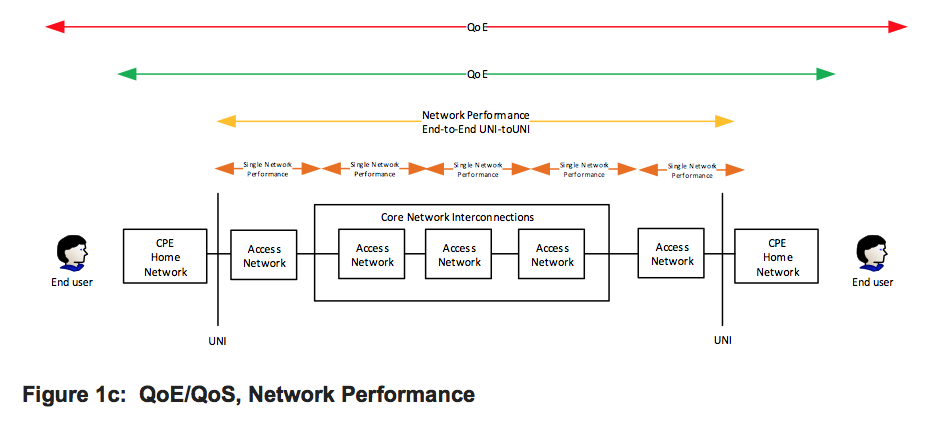by Neville Latchman
The recent debate regarding the open Internet, net neutrality, and the FCC regulatory framework has been controversial among policymakers and regulators. Net neutrality is an initiative that champions an open Internet, defined as an Internet: “promoting the ability of end-users to access and distribute information and/or run applications and services of their choice.”
The term quality has varying scope depending on the characteristics and elements of the communication system under consideration. The quality of a user’s interaction with services at the human-to-machine interface is appraised by the Quality of Service (QoS) concept. QoS, which comprises the network and the terminal equipment / Customer Premises Equipment (CPE), is measured end-to-end, per service. This is despite the fact that the terminal equipment (and user-controlled local network, if applicable) is usually not managed by the network provider.
For technical purposes, Network Performance (NP) is performance measurement of network portions under an individual provider’s control. Since the strict technical term QoS includes many variables outside the control of the network provider, many other factors impact network performance.
Degradation of network performance may be due to network congestion or targeted throttling of applications. Furthermore, congestion may occur two ways: it is either related to unpredictable situations occurring on an irregular basis, or by an operator’s failure to meet increased traffic load with sufficient capacity enhancement.
Internet access service provides connection to the public Internet and thereby connectivity among end users. Specialized services provide enhanced functionality including: access restrictions, strict service provisioning, and enhanced end-to-end quality and/or security. These service models represent characteristics that demonstrate varying degrees of openness and admission control.
QoS Concepts
Although an end user’s quality of experience including how it provides a potential indicator of network performance is the goal, the main objective for this QoS context evaluation is to identify degradation of service resulting either from congestion or from operators’ practices (e.g., priority given to selected traffic streams over others). Therefore, the approach is not necessarily to use QoS and quality of experience (QoE) concepts as defined by formal standards but to base the analysis on related knowledge to find methods to identify degradation of service.

Internet access including interconnection
The Internet involves thousands of interconnected networks. Network operation is autonomous and is therefore referred to as an Autonomous System (AS)1. Data communications paths within an AS are established using internal routing protocols. For end-to-end reachability through several ASs, an external routing protocol—an inter-Autonomous System routing protocol called the Border Gateway Protocol (BGP)2—is needed. BGP exchanges network reachability information between the ASs for calculating routes and eliminating loops. Routing decisions are determined based on path, network policies, and/or rule sets.
An Internet access service is a service that provides an end user with connectivity to the Internet. To do so, a Service Provider (SP) must operate and maintain an IP network—an Autonomous System as described herein—and connect it to the Internet via BGP. Internet access reaches from the User Network Interface (UNI) to an egress point of the SP’s AS connected to the public Internet. Egress points can be a direct connection to another AS or to an Internet Exchange Point (IXP) where several other global ASs may be reached. Any destination on the Internet is reached either directly through a connected network, or indirectly by routing to a destination via transit networks.
An Internet access service therefore enables the end user:
• to communicate with end users connected to the Internet
• to access content, services, and applications hosted on servers connected to the Internet
• to use content and applications that rely on the communication capabilities of the Internet
In comparison, applications or services on traditional legacy circuit-switched networks are not well integrated within their networks. Within an IP environment, services are generated at the terminal equipment (computer) while relying on the Internet as a transportation platform (also known as the “Network Layer”). The Internet by itself provides only a general electronic communications service.
Applications, services, and their relevant content are decoupled from the (physical and logical) network and can only use available transfer capacity without having any influence on the traffic management mechanisms practiced on it. The network does not interact with the applications; its only task is to convey the traffic according to a predefined policy. The Internet only provides connectivity between the ends executing the application functionality.
Some classic examples include voice-over IP (VoIP) and Skype real-time protocol (RTP) voice services (see Figure 1b). There are many sources of impairment that can affect the resulting QoS and are attributed to different portions of the network chain. The VoIP/RTP applications have certain minimum requirements for IP packet transmission that must be met to provide acceptable quality. If network layer quality is low, the end user will perceive that the VoIP/RTP application provides poor performance. Usually, the end user can neither identify the specific source of impairment, nor the party responsible for it. This must be done with methods that provide objective measures.

Network Performance, QoS and QoE
The universal definition of quality is: “The totality of characteristics of an entity that bear on its ability to satisfy stated and implied needs”3. Any part of a data communications system can be such an entity. Depending on the characteristics of interest and the portion of the communications system under consideration, the term quality has varying scope. From an engineering viewpoint, the performance of technical elements and functions are of interest. An end user interacts with the data communications infrastructure by accessing a service, resulting in a perception of the quality of this service. A user-centric perception of quality is given when rating the subjectively perceived service level, while considering context of use and user expectations.
Different concepts of quality are used in telecommunications:
• For technical purposes, concerning assessment and/or analysis of technical functions, the Network Performance (NP) concept is applied
• The users’ interaction with services at the human-machine interface is evaluated under the QoS concept
• The overall acceptability of a service may be subjectively perceived by an end user and expressed in terms of Quality of Experience
The three concepts and their scope of application are shown in the Figure 1c.
 Network, terminal and application performance
Network, terminal and application performance
The user-perceivable degradation of QoS/QoE is caused by either inadequate performance of the IP network, the terminal equipment/end user infrastructure, or a combination of both. Network performance and terminal performance are the building blocks of any end user service. The network(s) provide the connectivity and IP packet transfer capability between network termination points. The terminal equipment sends and receives packets to and from the network via the network adapter (line card). The adapter is controlled by the operating system of the terminal, which includes the implementation of several protocols, the so-called protocol stack. End-to end packet transfer performance is influenced by the performance of the hardware and software of the terminal equipment. Packet transfer capabilities are utilized when running an application. The application software installed on the terminal equipment executes functions at the application/content layer (information processing, content presentation, etc.) above the network layer as indicated in the figure below.

Network Performance (NP) is the ability of a network to provide the functions related to communications between users. Network performance is determined by the performance of each network element. The performance of the network holistically (end-to-end) is the sum of the performance of all single elements and their inter-connections. Network Performance is typically specified by objective performance parameters that are measurable and quantitatively assigned.
QoS is, as mentioned earlier, “the totality of characteristics of a telecommunications service that bear on its ability to satisfy stated and implied needs of the user of the service,” in which “service” is a set of functions offered to a user by an organization. QoS is always end-to-end, and user-to-user. QoS measurements are carried out end-to-end and can be objective (quantitative) or subjective (qualitative) parameters. QoS measurements indicate the performance of functions observable at the end user-interface of the service.
QoE is the overall acceptability of applications or services as perceived by an end user. It encompasses end-to-end system effects including client, terminal, network, and services infrastructure, and is swayed by user expectations and context. Therefore, QoE is measured subjectively by the end user and differs substantially from user to user. Complex statistical algorithms objectively describe the user experience and are contrasted with subjective measurements to determine network performance, QoS and QoE
Network Performance substantially contributes toward end-to-end QoS. These functions depend on the performance of the network elements and/or performance of the user’s equipment. QoS therefore comprises both network performance and non-network related performance.
QoS provides a quality rating of the collective performance of a set of functions that constitute the overall service. For example, in VoIP services QoS relates to the transmission path from mouth to ear. QoE is broader in scope. It is directly impacted by the performance of multiple QoS parameters and user expectations. There is a direct correlation between QoS parameters and QoE. This relationship between the aforementioned typically is estimated empirically and used in two ways: either the expected QoE for a user is predicted by QoS parameter measurements, or the net required QoS is deduced from a given target QoE for a user. As explained, QoS and QoE are end-to-end related; user-to-user or user to-content. QoS is a measure of the performance of a set of functions observable at the user interface of the service. QoE also includes user expectation and context. QoS and QoE observations and measurements can only reflect the quality as it is perceived by the end user, that is, as perceived at the service interface. It is not possible to identify the direct cause of quality degradation in technical terms.
The concepts of QoS and QoE are used to validate whether the standards specified by a Service Level Agreement (SLA) has been met or to determine the quality of a given service and user satisfaction with it. The QoS parameters for each specific service can be specified and measured. By doing so all features of a service can be monitored and verified for compliance against a reference quality level. For further investigation of causes of quality degradation and identification of possible malfunctioning network or terminal elements, a more detailed analysis is necessary. However, this requires access to the network(s) and terminals themselves, to perform specific diagnostic tests.
Conclusion
QoE thus provides a measure of the overall level of customer satisfaction with an OEM/vendor/Service Provider transport and/or application or service. QoE is related to but diverges from QoS, in that it represents the notion that hardware and/or software characteristics can be measured, improved, and even guaranteed. As mentioned, QoE presently utilizes subjective quality assessments as they relate to the user experience over the global Internet Service Provider networks.
Within the Internet, networks support extensive services. These services may have varying QoS requirements based on an end user’s perceptions. New QoS policies are therefore mandated that will adapt the traditional QoS regulatory model to these emerging circumstances. In the next discussion of this series (Part II) we will evaluate a user-centric approach to identifying key factors that would contribute to the development of an ideal QoS framework. This application framework for a user-centric QoS model will be a catalyst for, and critical to the success of, net neutrality as the Internet and its services evolve.
References:
IEEE Communications Society, Can Blockchain Strengthen the Internet of Things, 12/2017
Jaspec, blog.packet-foo.com, Determining TCP Initial Roundtrip Time, 07/2014
ITU, 2001, A Framework for QoS, 12/2011
IEEE Communications Society, Internet QoS in Future Networks: A User Centric Approach, 10/2011

Recent Comments